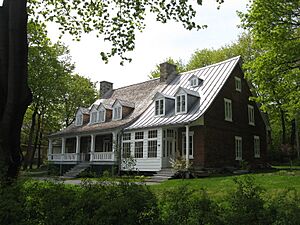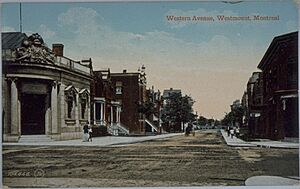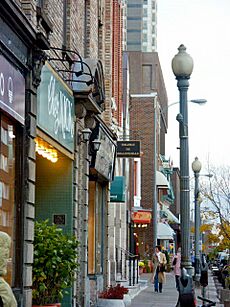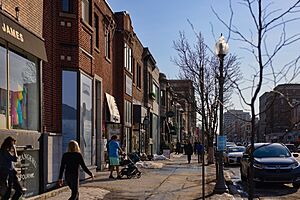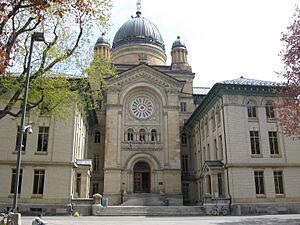Westmount facts for kids
Quick facts for kids
Westmount
|
||
|---|---|---|
|
City
|
||
| City of Westmount Ville de Westmount |
||
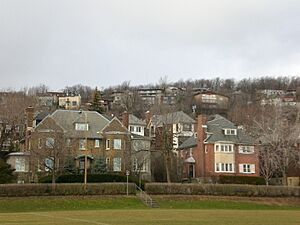
Upper Westmount and Westmount Summit seen from King George Park.
|
||
|
||
| Motto(s):
Robur meum civium fides (Latin for: "My strength is the faithfulness of my citizens")
|
||

Location on the Island of Montreal
|
||
| Country | Canada | |
| Province | Quebec | |
| Region | Montreal | |
| RCM | None | |
| Founded | 1874 | |
| Constituted | January 1, 2006 | |
| Area | ||
| • Total | 4.02 km2 (1.55 sq mi) | |
| • Land | 4.04 km2 (1.56 sq mi) | |
| There is an apparent contradiction between 2 authoritative sources. | ||
| Population
(2021)
|
||
| • Total | 19,658 | |
| • Density | 4,860.9/km2 (12,590/sq mi) | |
| • Dwellings | 9,423 | |
| Demonym(s) | Westmounter | |
| Time zone | UTC−05:00 (EST) | |
| • Summer (DST) | UTC−04:00 (EDT) | |
| Postal code(s) |
H3Y and H3Z
|
|
| Area code(s) | 514 and 438 | |
| Highways | ||
Westmount is a city located on the Island of Montreal in southwestern Quebec, Canada. It is like a small town completely surrounded by the larger city of Montreal. In 2021, about 19,658 people lived there.
Westmount has many great places for kids and families. It has schools, a sports arena, a swimming pool, a public library, and several parks. Some popular parks include Westmount Park and King George Park. The city even has its own electricity company, Hydro-Westmount. It is also home to two Canadian military reserve units.
For a long time, Westmount has been known as a wealthy area. Many people who live there speak English. It used to be one of the richest communities in Canada. Today, it is still one of the most well-off neighborhoods outside of Toronto and Vancouver.
Contents
Westmount's History
There is proof that First Nations people lived in the Westmount area thousands of years ago. Many old burial sites have been found there. The Anishinaabe and Haudenosaunee (Iroquois) peoples lived on the Island of Montreal for a long time.
When French settlers first arrived in the mid-1600s, this area had different names like La Petite Montagne. The Hurtubise House, a former farmhouse from that time, is the oldest house still standing in Westmount.
The area was first set up as the Village of Côte St-Antoine in 1874. It later became the Town of Côte St-Antoine. In 1895, it was renamed Westmount. This new name showed its location on the southwest side of Mount Royal. It also reflected the many English-speaking people living there.
In the 1900s, Westmount grew into a rich suburb of Montreal. It became a city with many green spaces. An architect named Robert Findlay lived in Westmount. He designed many of the city's buildings, like the library and Westmount City Hall.
During the 20th century, famous wealthy families like the Bronfmans and the Molsons lived in Westmount. The city faced some challenges in the 1960s. Later, in 1987, Montreal renamed Dorchester Boulevard to René Lévesque Boulevard. Westmount decided to keep the name Dorchester for its part of the street.
Becoming Part of Montreal and Then Independent Again
In 2002, Westmount became part of the city of Montreal. It was made into a borough, which is like a district within a larger city. However, after a few years, people voted to make Westmount an independent city again. On January 1, 2006, Westmount became its own city once more.
Today, Westmount is one of fifteen independent cities on the Island of Montreal. It is the only one that directly touches the downtown area of Montreal. Even though it is independent, Westmount still works with Montreal on some services. These include police, fire protection, and public transportation.
Westmount's Location
Westmount covers about 4 square kilometers (1.5 square miles). It is located on the south side of Westmount Summit, which is the western peak of Mount Royal. Most of the city is on a steep hill, stretching from the top of the mountain down to the flat land at its base.
City Life and Buildings
Most of Westmount is made up of homes. The houses get bigger and more expensive as you go up the mountain. The largest and most costly homes are found near Summit Circle.
Some important buildings in Westmount include Place Alexis Nihon and the Westmount Square complex. Ludwig Mies van der Rohe designed Westmount Square. A Westmount resident named Samuel Bronfman, who started the Seagram liquor company, helped pay for it.
Westmount also has several small shopping areas. You can find them on Sherbrooke Street, in an area called "Victoria Village". There are also shops on Saint Catherine Street near Place Alexis Nihon, on Greene Avenue, and on De Maisonneuve Boulevard close to the Atwater metro station.
Westmount's Green Spaces
Westmount has many parks. Some of the main ones are Westmount Park and King George Park (also known as Murray Hill). Summit Woods is a popular forest area. It is a great place for walking and for dogs to play.
Westmount Park Fun
Westmount Park is the second largest park in the city. It is located between Sherbrooke Street and De Maisonneuve Boulevard. The park was designed in 1912. It has large playing fields, the Westmount Arena, and a swimming pool.
In the middle of the park, you will find a big playground, walking paths, ponds, and tennis courts. The Westmount Public Library, built in 1897, and Victoria Hall are also located on the north side of the park. There is also a large greenhouse.
Westmount's People
|
|||||||||||||||||||||||||||||||||||||||||||||
Westmount is officially a bilingual city. This means both English and French are used there.
In 2021, Westmount had 19,658 people living in 8,591 homes. The city has a population density of about 4,861 people per square kilometer.
| Language | Number of People | Percentage (%) |
|---|---|---|
| English | 12,920 | 69% |
| French | 3,705 | 20% |
| Other | 2,170 | 11% |
| Language | Number of People | Percentage (%) |
|---|---|---|
| English | 10,225 | 54% |
| French | 4,235 | 22% |
| Other | 4,600 | 24% |
| Group | Number of People | Percentage (%) |
|---|---|---|
| Not a visible minority | 16,225 | 82.0% |
| Visible minorities | 3,565 | 18.0% |
In 2015, the average income after taxes in Westmount was $41,674. Many people in Westmount work in management, business, or education, law, and government services. Each of these areas employed about 20% of the workers.
Sports in Westmount
Westmount was once home to the Montreal Arena. This was one of the first buildings ever made just for hockey! It was where the Montreal Wanderers and the famous Montreal Canadiens played. The arena burned down in 1918.
In 2013, a new sports center called the Westmount Recreation Centre opened. It has two new ice rinks, a bigger swimming pool, and updated tennis courts. It is home to local hockey teams like the Westmount Wings and Lasalle/Westmount Cobras.
Westmount also has the Westmount Lynx Lacrosse Club. They have field lacrosse teams for boys and girls aged 8 to 16. The Westmount Rugby Club is the oldest active rugby club in North America. The city's swim team, the Westmount Dolphins, won the Section B Alps finals in 2007.
Famous tennis player Eugenie Bouchard grew up in Westmount.
Learning in Westmount
Westmount has two CEGEPs (colleges in Quebec):
- Dawson College (public, English-speaking)
- Marianopolis College (private, English-speaking)
The Commission scolaire de Montréal (CSDM) runs French-language schools in Westmount.
English-language public schools are managed by the English Montreal School Board (EMSB). These include:
- Westmount High School
- Westmount Park School (elementary)
- Roslyn Elementary School (known for starting the first French Immersion Program on the Island of Montreal in 1968)
Westmount also has several private schools:
- St. George's School of Montreal (for boys and girls)
- Miss Edgar's and Miss Cramp's School (for girls)
- The Study (for girls)
- Villa Sainte-Marcelline (French-language, for girls)
- Selwyn House School (for boys)
The Montreal Hoshuko School, a Japanese supplementary school, used to hold classes at Westmount Park School.
Sister Cities
Westmount is connected with another city in a special way, like a "sister city."
- Rimouski, Quebec, Canada (since 1968)
Famous People from Westmount
Many well-known people have connections to Westmount:
- Musicians Leonard Cohen and Sam Roberts were born here.
- Actress and comedian Caroline Rhea was also born in Westmount.
- Federal Member of Parliament and former astronaut Marc Garneau lives in Westmount.
- MMA journalist Ariel Helwani grew up in Westmount.
- United States Vice President Kamala Harris lived in the area for part of her childhood and went to Westmount High School.
Westmount in Stories
Westmount has been the setting for many novels:
- Gwethalyn Graham's book Earth and High Heaven (World War II story).
- David Montrose's detective novel The Crime on Cote des Neiges (later translated as Meurtre à Westmount).
- Daniel Richler's Kicking Tomorrow (about a teenager in the 1970s).
- Claire Rothman's Lear's Shadow (takes place in Westmount Park).
- Edward Openshaw Phillips wrote mystery novels set in Westmount.
See also
 In Spanish: Westmount para niños
In Spanish: Westmount para niños




